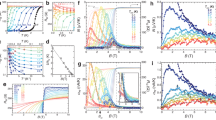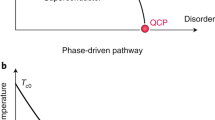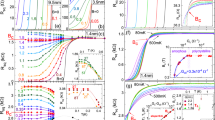Abstract
The interplay of superconductivity and disorder has intrigued scientists for several decades. Disorder is expected to enhance the electrical resistance of a system, whereas superconductivity is associated with a zero-resistance state. Although superconductivity has been predicted to persist even in the presence of disorder1, experiments performed on thin films have demonstrated a transition from a superconducting to an insulating state with increasing disorder or magnetic field2. The nature of this transition is still under debate, and the subject has become even more relevant with the realization that high-transition-temperature (high-Tc) superconductors are intrinsically disordered3,4,5. Here we present numerical simulations of the superconductor–insulator transition in two-dimensional disordered superconductors, starting from a microscopic description that includes thermal phase fluctuations. We demonstrate explicitly that disorder leads to the formation of islands where the superconducting order is high. For weak disorder, or high electron density, increasing the magnetic field results in the eventual vanishing of the amplitude of the superconducting order parameter, thereby forming an insulating state. On the other hand, at lower electron densities or higher disorder, increasing the magnetic field suppresses the correlations between the phases of the superconducting order parameter in different islands, giving rise to a different type of superconductor–insulator transition. One of the important predictions of this work is that in the regime of high disorder, there are still superconducting islands in the sample, even on the insulating side of the transition. This result, which is consistent with experiments6,7, explains the recently observed huge magneto-resistance peak in disordered thin films8,9,10 and may be relevant to the observation of ‘the pseudogap phenomenon’ in underdoped high-Tc superconductors11,12.
This is a preview of subscription content, access via your institution
Access options
Subscribe to this journal
Receive 51 print issues and online access
$199.00 per year
only $3.90 per issue
Buy this article
- Purchase on Springer Link
- Instant access to full article PDF
Prices may be subject to local taxes which are calculated during checkout



Similar content being viewed by others
References
Anderson, P. W. Theory of dirty superconductors. J. Phys. Chem. Solids 11, 26–30 (1959)
Goldman, A. M. & Markovic, N. Superconductor-insulator transitions in the two-dimensional limit. Phys. Today 51, 39–44 (1998)
Reich, S. et al. Localized high-Tc superconductivity on the surface of Na-doped WO 3. J. Superconductivity 13, 855–861 (2000)
Cren, T., Roditchev, D., Sacks, W. & Klein, J. Nanometer scale mapping of the density of states in an inhomogeneous superconductor. Europhys. Lett. 54, 84–90 (2001)
Pan, S. H. et al. Microscopic electronic inhomogeneity in the high-Tc superconductor Bi2Sr2CaCu2O8+x . Nature 413, 282–285 (2001)
Kowal, D. & Ovadyahu, Z. Disorder induced granularity in an amorphous superconductor. Solid State Commun. 90, 783–786 (1994)
Crane, R. W. et al. Survival of superconducting correlations across the two-dimensional superconductor-insulator transition: A finite-frequency study. Phys. Rev. B 75, 184530 (2007)
Paalanen, M. A., Hebard, A. F. & Ruel, R. R. Low-temperature insulating phases of uniformly disordered two-dimensional superconductors. Phys. Rev. Lett. 69, 1604–1607 (1992)
Gantmakher, V. F., Golubkov, M. V., Lok, J. G. S. & Geim, A. K. Giant negative magnetoresistance of semi-insulating amorphous indium oxide films in strong magnetic fields. J. Exp. Theor. Phys. 82, 951–958 (1996)
Sambandamurthy, G., Engel, L. W., Johansson, A. & Shahar, D. Superconductivity-related insulating behavior. Phys. Rev. Lett. 92, 107005 (2004)
Timusk, T. & Statt, B. The pseudogap in high-temperature superconductors: an experimental survey. Rep. Prog. Phys. 62, 61–122 (1999)
Alvarez, G., Mayr, M., Moreo, A. & Dagotto, E. Areas of superconductivity and giant proximity effects in underdoped cuprates. Phys. Rev. B 71, 014514 (2005)
Bardeen, J., Cooper, L. N. & Schrieffer, J. R. Theory of superconductivity. Phys. Rev. 108, 1175–1204 (1957)
Ma, M. & Lee, P. A. Localized superconductors. Phys. Rev. B 32, 5658–5667 (1985)
Fisher, M. P. A., Grinstein, G. & Girvin, S. M. Presence of quantum diffusion in two dimensions: Universal resistance at the superconductor-insulator transition. Phys. Rev. Lett. 64, 587–590 (1990)
Fisher, M. P. A. Quantum phase transitions in disordered two-dimensional superconductors. Phys. Rev. Lett. 65, 923–926 (1990)
Galitski, V. M. & Larkin, A. I. Disorder and quantum fluctuations in superconducting films in strong magnetic fields. Phys. Rev. Lett. 87, 087001 (2001)
Ghosal, A., Randeria, M. & Trivedi, N. Role of spatial amplitude fluctuations in highly disordered s-wave superconductors. Phys. Rev. Lett. 81, 3940–3943 (1998)
De-Gennes, P. G. Superconductivity of Metals and Alloys (W. A. Benjamin, New York, 1966)
Mayr, M., Alvarez, G., Sen, C. & Dagotto, E. Phase fluctuations in strongly coupled d-wave superconductors. Phys. Rev. Lett. 94, 217001 (2005)
Dubi, Y., Meir, Y. & Avishai, Y. Theory of magneto-resistance in disordered superconducting films. Phys. Rev. B 73, 054509 (2006)
Clogston, A. M. Upper limit for the critical field in hard superconductors. Phys. Rev. Lett. 9, 266–267 (1962)
Chandrasekhar, B. S. A note on the maximum critical field of high-field superconductors. Appl. Phys. Lett. 1, 7–8 (1962)
Ephron, D., Yazdani, A., Kapitulnik, A. & Beasley, M. R. Observation of quantum dissipation in the vortex state of a highly disordered superconducting thin film. Phys. Rev. Lett. 76, 1529–1532 (1996)
Aubin, H. et al. Magnetic-field-induced quantum superconductor-insulator transition in Nb0. 15Si0. 85 . Phys. Rev. B 73, 094521 (2006)
Hebard, A. F. & Paalanen, M. A. Magnetic-field-tuned superconductor-insulator transition in two-dimensional films. Phys. Rev. Lett. 65, 927–930 (1990)
Yazdani, A. & Kapitulnik, A. Superconducting-insulating transition in two-dimensional a-MoGe thin films. Phys. Rev. Lett. 74, 3037–3040 (1995)
Das Gupta, K., Sambandamurthy, G., Soman, S. S. & Chandrasekhar, N. Possible robust insulator-superconductor transition on solid inert gas and other substrates. Phys. Rev. B 63, 104502 (2001)
Baturina, T. I. et al. Superconductivity on the localization threshold and magnetic-field-tuned superconductor-insulator transition in TiN films. JETP Lett. 79, 337–341 (2004)
Emery, V. J. & Kivelson, S. A. Importance of phase fluctuations in superconductors with small superfluid density. Nature 374, 434–437 (1995)
Acknowledgements
We acknowledge discussions with A. Auerbach. This work was carried out with the support of the Israel Science Foundation and the US-Israel Binational Science Foundation. Y.D. acknowledges support from a Kreitman fellowship. Y.M. acknowledges the hospitality of the Aspen Center of Physics. Y.A. acknowledges JSPS fellowship.
Author information
Authors and Affiliations
Corresponding author
Ethics declarations
Competing interests
The authors declare no competing financial interests.
Rights and permissions
About this article
Cite this article
Dubi, Y., Meir, Y. & Avishai, Y. Nature of the superconductor–insulator transition in disordered superconductors. Nature 449, 876–880 (2007). https://doi.org/10.1038/nature06180
Received:
Accepted:
Issue Date:
DOI: https://doi.org/10.1038/nature06180
This article is cited by
-
Interdependent superconducting networks
Nature Physics (2023)
-
Correlated disorder as a way towards robust superconductivity
Communications Physics (2022)
-
Robustness of superconductivity to external pressure in high-entropy-alloy-type metal telluride AgInSnPbBiTe5
Scientific Reports (2022)
-
Spin gauge theory, duality and fermion pairing
Journal of High Energy Physics (2022)
-
A robust nitridation technique for fabrication of disordered superconducting TiN thin films featuring phase slip events
Scientific Reports (2021)
Comments
By submitting a comment you agree to abide by our Terms and Community Guidelines. If you find something abusive or that does not comply with our terms or guidelines please flag it as inappropriate.



